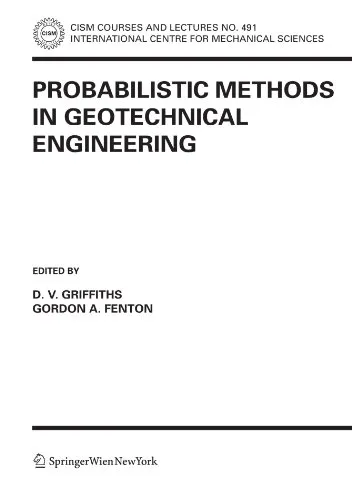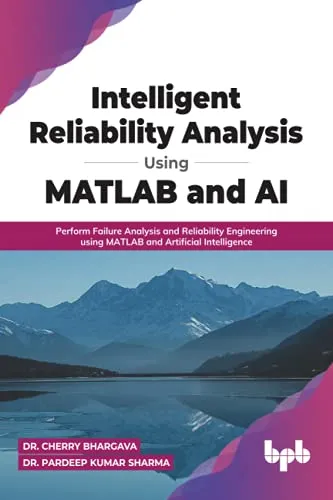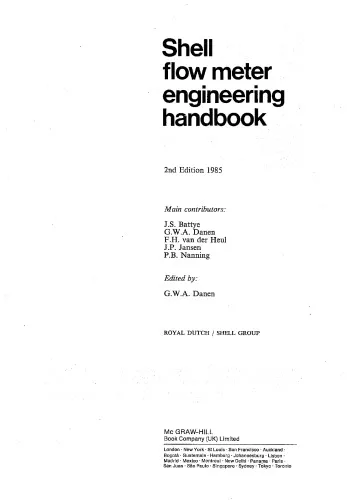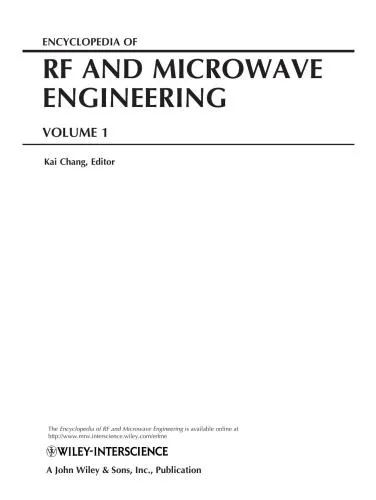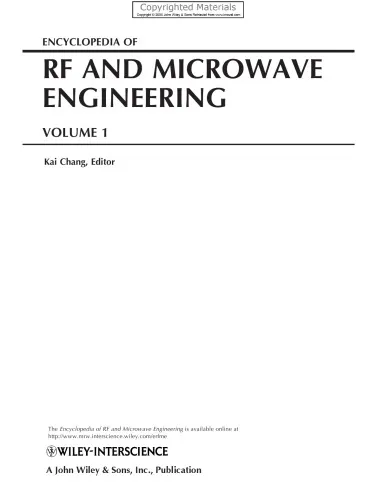Probabilistic Methods in Geotechnical Engineering (CISM International Centre for Mechanical Sciences)
4.5
بر اساس نظر کاربران

شما میتونید سوالاتتون در باره کتاب رو از هوش مصنوعیش بعد از ورود بپرسید
هر دانلود یا پرسش از هوش مصنوعی 2 امتیاز لازم دارد، برای بدست آوردن امتیاز رایگان، به صفحه ی راهنمای امتیازات سر بزنید و یک سری کار ارزشمند انجام بدینکتاب های مرتبط:
مقدمهای جامع بر کتاب «Probabilistic Methods in Geotechnical Engineering»
کتاب «Probabilistic Methods in Geotechnical Engineering» اثر مشترک D. V. Griffiths و G. A. Fenton، یکی از منابع کلیدی و مدرن در زمینه استفاده از روشهای احتمالاتی در مهندسی ژئوتکنیک است. این کتاب بهعنوان بخشی از مجموعه معتبر CISM International Centre for Mechanical Sciences منتشر شده و با هدف معرفی رویکردهای نوین تحلیل و طراحی سازههای ژئوتکنیکی در شرایط عدم قطعیت نگارش شده است.
خلاصهای از کتاب
در این کتاب، نویسندگان تمرکز خود را بر ارائه مفاهیمی همچون آمار، تحلیل دادهها و مدلسازی احتمالاتی قرار دادهاند که برای حل مسائل پیچیده ژئوتکنیکی مورد استفاده قرار میگیرد. در دنیای واقعی، شرایط خاک و رفتار آن با عدم قطعیتهای زیادی همراه است؛ از جمله تغییرات طبیعی خصوصیات خاک، تفاوتهای منطقهای، و محدودیتهای مربوط به اندازهگیریهای آزمایشگاهی. این کتاب از دادههای آماری و روشهای Monte Carlo Simulation برای تحلیل اینگونه شرایط بهره میبرد و به مهندسان کمک میکند تا تصمیمات بهینهتری اتخاذ کنند.
از مباحث پیشرفتهی مورد بحث در این کتاب میتوان به توزیعهای احتمالاتی، تحلیل ریسک، و مدیریت طراحی ژئوتکنیکی اشاره کرد. همچنین کاربردهای عملی در طراحی دیوارهای حائل، شیبهای خاکی، و پیهای سازههای مختلف بهطور جامع بررسی شده است.
نکات کلیدی که از مطالعه کتاب خواهید آموخت
- درک اهمیت استفاده از تحلیل احتمالاتی در مهندسی ژئوتکنیک
- آشنایی با کاربردهای عملی روشهای Monte Carlo Simulation در پروژههای ژئوتکنیکی
- توانایی تحلیل و مدیریت ریسک در طراحی ژئوتکنیکی
- شناخت بهتر عدم قطعیتها و روشهای کاهش تاثیرات مخرب آنها بر پروژههای مهندسی
- بهبود توانایی مدلسازی و تصمیمگیری در شرایط پیچیده
جملات معروف از کتاب
"Uncertainty in geotechnical engineering is not the enemy; it is an opportunity for better decision-making when managed appropriately."
"Probabilistic methods provide engineers with a framework to embrace complexity and variability inherent in soil properties."
چرا مطالعه این کتاب مهم است؟
مطالعه این کتاب نه تنها برای مهندسان ژئوتکنیک بلکه برای متخصصینی که در سایر حوزههای مرتبط با مدیریت ریسک فعالیت میکنند حیاتی است. با توجه به اینکه زمینشناسی و شرایط خاکی همیشه شامل عدم قطعیتهایی هستند، توانایی تحلیل و پیشبینی رفتار خاک در واقعیت میتواند نتایج پروژهها را بهبود بخشد و خطرات احتمالی را کاهش دهد. همچنین، در دنیای امروز که روشهای عددی و رایانهای نقش فزایندهای در تحلیلهای مهندسی دارند، درک رویکردهای ارائه شده در این کتاب میتواند باعث تحول در دیدگاهها و روشهای طراحی شود.
این کتاب به شما کمک میکند تا از رویکردهای سنتی فاصله گرفته و به روشی دقیقتر و علمیتر برای مدیریت پروژههای ژئوتکنیکی دست پیدا کنید. نهایتاً، آنچه این کتاب را منحصر به فرد میکند، ترکیب تئوریهای محاسباتی با کاربردهای عملی برای حل مسائل واقعی در مهندسی زمینشناسی است.
Welcome to the introduction of Probabilistic Methods in Geotechnical Engineering, a groundbreaking work authored by D.V. Griffiths and G.A. Fenton, published by the CISM International Centre for Mechanical Sciences. This comprehensive book serves as a critical resource for engineers, researchers, and academics seeking to understand and implement probabilistic models in the field of geotechnical engineering.
Summary of the Book
The book delves into probabilistic and stochastic approaches in geotechnical engineering, which provide a departure from traditional deterministic methods. While conventional geotechnical engineering often relies on fixed parameters and assumptions, this book focuses on incorporating uncertainty into designs and decision-making processes. The authors aim to bridge the gap between theory and practice, offering readers insights into concepts like variability, random fields, risk assessment, and Monte Carlo simulations.
Each chapter is meticulously crafted to explore topics ranging from fundamental probability concepts to advanced modeling techniques. The text is rich with numerical examples, case studies, and exhaustive explanations of methods, allowing readers to see the practical applications of probabilistic techniques in real-world scenarios. By integrating statistical analyses into the study of soil mechanics and foundation design, the book equips professionals to address uncertainty and variability in geotechnical properties, such as cohesion, friction angle, and permeability.
Written in an accessible style, the book is suitable both as a textbook for upper-level undergraduate and graduate courses, as well as a reference guide for practitioners in the field. Its interdisciplinary perspective merges civil engineering concepts with applied mathematics and statistics, making it an invaluable resource across disciplines.
Key Takeaways
- Understand the importance of uncertainty and variability in geotechnical engineering practices.
- Learn foundational concepts in probability and statistics relevant to soil mechanics and structural analysis.
- Explore state-of-the-art tools, including random field theory and Monte Carlo simulations.
- Gain insights into the application of probabilistic methods for risk evaluation in engineering design.
- Develop solutions for complex geotechnical problems through detailed examples and case studies provided in the book.
Famous Quotes from the Book
"The role of uncertainty is not to be feared but instead embraced as an integral aspect of engineering analysis."
"By incorporating probabilistic methods, engineers can better address spatial variability and improve decision-making under uncertainty."
"The transition from deterministic to probabilistic thinking in geotechnical engineering is not a luxury; it is a necessity."
Why This Book Matters
The relevance of Probabilistic Methods in Geotechnical Engineering lies in its ability to address challenges of uncertainty, variability, and risk—factors that are omnipresent in the natural conditions underlying engineering projects. As practitioners face increasing demands for safety, performance reliability, and cost efficiency, the use of probabilistic methods becomes indispensable.
Geotechnical failures can have severe consequences both monetarily and socially, making risk assessment paramount in the design process. This book equips engineers to move beyond deterministic assumptions, offering tools to forecast uncertainties, evaluate risks comprehensively, and make informed decisions that account for variability. By fostering such competencies, the book contributes to safer and more efficient engineering practices.
Moreover, the interdisciplinary nature of the book makes it a significant addition to the engineering canon. Its application extends beyond geotechnical projects, offering robust methodologies pertinent to a wide array of disciplines. Students, educators, and professionals alike will find its content inspiring and transformative, ensuring its continued relevance in a constantly evolving industry.
دانلود رایگان مستقیم
شما میتونید سوالاتتون در باره کتاب رو از هوش مصنوعیش بعد از ورود بپرسید
دسترسی به کتابها از طریق پلتفرمهای قانونی و کتابخانههای عمومی نه تنها از حقوق نویسندگان و ناشران حمایت میکند، بلکه به پایداری فرهنگ کتابخوانی نیز کمک میرساند. پیش از دانلود، لحظهای به بررسی این گزینهها فکر کنید.
این کتاب رو در پلتفرم های دیگه ببینید
WorldCat به شما کمک میکنه تا کتاب ها رو در کتابخانه های سراسر دنیا پیدا کنید
امتیازها، نظرات تخصصی و صحبت ها درباره کتاب را در Goodreads ببینید
کتابهای کمیاب یا دست دوم را در AbeBooks پیدا کنید و بخرید
1171
بازدید4.5
امتیاز0
نظر98%
رضایتنظرات:
4.5
بر اساس 0 نظر کاربران
Questions & Answers
Ask questions about this book or help others by answering
No questions yet. Be the first to ask!
